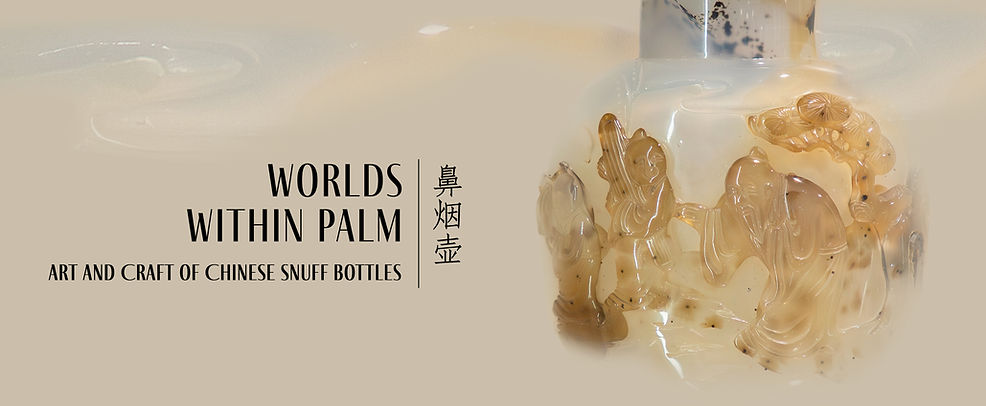Carved Chalcedony Agate Snuff Bottles
Gift from Bill Burd

Exhibit Information
Carved Chalcedony Agate Snuff Bottles
Gift of Bill Burd
Qing Dynasty, 1750–1850
The snuff bottles on display are intricately carved from chalcedony agate, showcasing a mastery of technique that transforms the stone’s natural color layers—or “skin”—into vivid depictions of figures, immortals, flora, and fauna. These miniature masterpieces evoke the appearance of painting through the expert manipulation of the material’s natural hues and textures. While the fall of the Qing Dynasty marked a decline in the use and production of snuff bottles, they remain enduring symbols of the refinement and beauty of traditional Chinese art.
Snuff Bottle 鼻 烟 壶
Snuff bottles were small, intricately crafted containers used in Qing dynasty China (1644–1912) to hold powdered tobacco, or snuff, which was believed to have medicinal properties. Because smoking tobacco was illegal during much of the Qing era, snuff—taken by inhalation—became a socially acceptable alternative. These bottles, often made of materials like glass, jade, porcelain, ivory, and agate, were not only utilitarian but also works of art, reflecting the craftsmanship, symbolism, and aesthetic preferences of the time. They were carried on the person and often exchanged as gifts, making them both personal accessories and markers of taste, status, and identity.
Snuff 鼻 烟
Snuff is a type of smokeless tobacco product. Tobacco is ground into a very fine powder and inhaled through the nose, allowing the nicotine to be absorbed through the nasal cavity. Medicinal ingredients such as musk or flower extracts may be added to enhance its effects. The aroma of snuff is traditionally categorized into five types: rancid 膻, burnt 糊, sour 酸, bean-like 豆, and bitter 苦. Because snuff ferments easily when stored in snuff bottles, it is usually sealed with wax and aged for several years or even decades before being sold.
Snuff originated in the Americas. In 1503, Spanish friar Ramón Pané accompanied Columbus on his second voyage and observed Indigenous peoples using this curious substance—powdered tobacco inhaled through the nose. He brought the practice back to Europe, where it became popular in the 17th century.
Snuff was introduced to China during the Longqing reign 隆庆 of the Ming dynasty 明, over 400 years ago. According to Qing scholar Zhao Zhiqian's 赵之谦 Yonglu Xianjie 《勇庐闲诘》, in the ninth year of the Wanli reign 万历九年 (1581), Italian missionary Matteo Ricci brought snuff, self-ringing clocks, and world maps as tribute while conducting missionary work. However, the official Ming court records listing "gifts presented by Matteo Ricci" do not mention snuff. Early on, snuff was referred to in Chinese by various transliterations such as "Shi Na Hu 士拿乎," "Shi Na Fu 士拿富," "Xi La 西腊," "Bu Lu Hui Lu 布露辉卢," and "Ke Lun Shi Na Hu 科伦士拿乎." During the Yongzheng 雍正 Emperor’s reign in the Qing dynasty 清, he renamed it “Bi Yan” 鼻烟, literally “nose tobacco,” based on the method of inhalation. From that point, snuff had an established Chinese name. After being introduced into the imperial court, the emperor began gifting snuff and snuff bottles to officials, spreading its popularity among the upper class.
In the early period, snuff was mainly imported from Germany, Spain, France, and Thailand (especially Germany), and was very expensive. Only bureaucrats and nobles could afford it. After the opening of five treaty ports during the Daoguang reign 道光, merchants in Guangzhou 广州 began producing imitation snuff using domestic tobacco, making it more widely accessible to the general public. By the late Qing period, however, snuff gradually lost popularity and was replaced by dry tobacco, water pipes, and cigarettes, eventually falling out of use in society.





